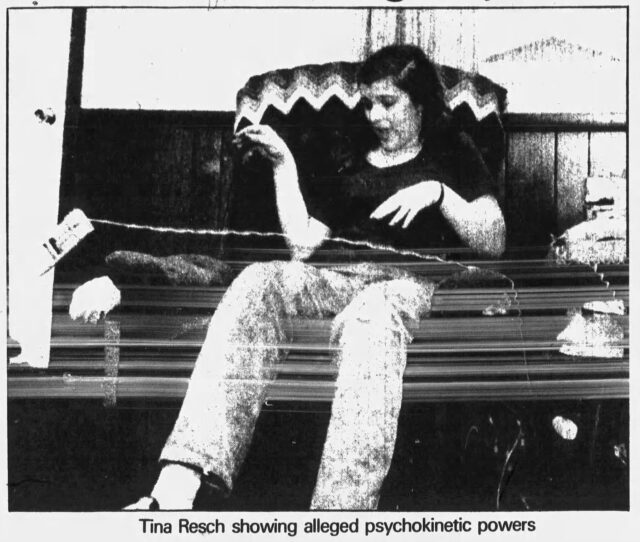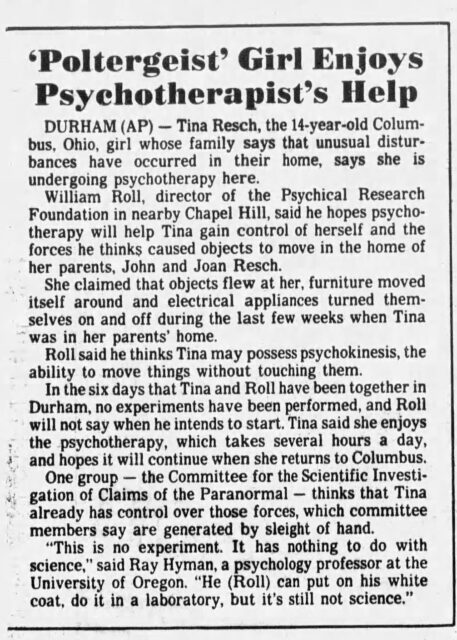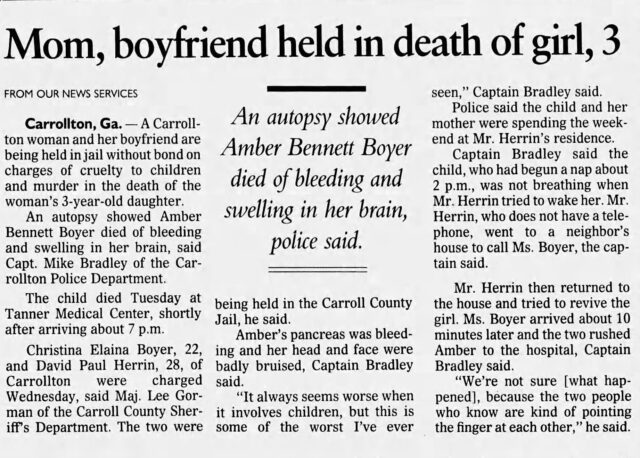
The Demons & Saviors synopsis explained that the three-part docuseries would tell “the remarkable story of Christina Boyer –once infamously known as the ‘poltergeist girl,’ now a woman convicted of murdering her three-year-old daughter.”
The trouble is, did she really murder her daughter, or was she wrongly convicted? That’s what Demons & Saviors examines, along with the quest to prove her innocence.
It sounded interesting, so I watched the trailer. Mainly to try and figure out who this “poltergeist girl” was. The only one I was familiar with was Heather O’Rourke, the child actress who starred in the Poltergeist movies. (And who tragically died while filming the third one.)
But watching the Demons & Saviors trailer prompted more questions, specifically these two:
- Why was Christina Boyer called the poltergeist girl if she demonstrated telekinetic powers?
- Why can’t I find any news stories about Christina Boyer being a poltergeist girl?
Demons & Saviors started streaming on Hulu on Thursday, August 3. The first episode held the answers to my initial questions. The last episode left me asking one more, “Would Team Christina get her out of jail?”
How She Earned the Name “Poltergeist Girl”
From what the trailer showed, she wasn’t experiencing a classic haunting. They specifically shared how she’d demonstrated telekinetic abilities as a teenager. So why was she being called the poltergeist girl?
She could’ve just as easily been called the Exorcist girl or the Carrie girl —and probably would’ve been if her story had come to light nearer to when either of those movies were released. But the supernatural hit Poltergeist was still fresh on everyone’s minds, and she claimed things were flying around her house like they had in the movie.
Except it wasn’t ghosts, but herself, that seemed to be causing it.
Wrong Name
The trailer looked super interesting, but why hadn’t I ever heard about Christina Boyer before? This seemed like a big story.
I headed to Newspapers.com and searched “poltergeist girl” and “Christina Boyer.” It returned a perplexing zero matches.
What the heck?
So I tried just “poltergeist girl.” As you might imagine, it returned a lot of results for the little girl in the Poltergeist movie, but also ones from decades before it —in the early 1900s as well as the 1920s.
But there was one curious result for a 14-year-old girl named Tina Resch from Columbus, Ohio, in a North Carolina newspaper. I initially disregarded it, thinking it had showed up by mistake.

Next, I tried “Christina Boyer.” That pulled up too many results, and the ones that included info about the murder made no mention of her being a poltergeist girl. What was I missing?
The first moments of the first episode cleared it up. Christina Boyer had formerly been known as Tina Resch —the same girl mentioned in the Winston-Salem Journal article.
The Poltergeist Girl Photo
Back to why she was called the poltergeist girl. It had to do with a particular photograph, one that often accompanied newspaper stories about her afterward.
In 1982, a photographer and reporter named Fred Shannon caught wind of Resch’s abilities. He went to Tina’s house in Columbus to investigate. That’s when he took a photo of a phone flying in front of her —that she allegedly hadn’t touched.
Compelling, but video would’ve been better. Especially because many called it fake, including one of the greatest debunkers of all, magician James Randi. It wasn’t long after he started looking into the “poltergeist girl” that his assumptions about her were proven true.
Once Shannon’s photo got out, other reporters clamored to catch evidence. A group of them gathered one day and waited hours for something to happen. During a break, one left his video camera rolling. It captured Resch faking a lamp falling.
That’s all it took to ruin her paranormal rep in the eyes of the public, but psychotherapist William Roll still believed she was the real deal. He brought her to North Carolina and subjected her to studies, which he wrote a book about.
Roll’s not portrayed kindly in the Demons & Saviors doc. If he made money off what he wrote about Christina, he never shared any with her. Worse, it seems like he basically discarded her after her usefulness to him was done.
Sad Circumstances
Was Christina Boyer a victim or villain? For all I know, she may have been both, but she definitely got dealt a hard hand of cards in this lifetime. Apparently, her mom was a prostitute and her dad was a pimp. Even though her mom had other kids, she put Christina (or “Tina,” as she was known then) up for adoption. That’s how she ended up living with the Resch family.
Boyer claimed Joan and John Resche disciplined her by locking her in her room at times. John would sometimes deliver “justice” in the form of beatings. But worst of all she suffered sexual abuse from the Resches’ son, who later would be sentenced to 20 years in jail for sexual assault. Her supernatural powers manifested around the time of her molestation.
As far as faking those powers with the lamp stunt, she explains she just wanted to make the reporters happy. They’d come to see her do something, nothing was happening, her mother was getting embarrassed, so Boyer (nee Resch) made something happen.
She was 14 and desperate to be accepted and loved. Her whole life, that’s all she wanted. It’s easy to see how, whether she really had telekinetic abilities or not, the attention from it would be welcome.
It’s also easy to see how the lack of love in her life led her to make other bad decisions, including running away. That’s how she wound up in another abusive relationship. She fled that one, too, but now she had a daughter to care for also, which is why she moved to Carrollton, Georgia. That’s where Jeannie Lagle lived, one of the only people to be nice to her. They met because Lagle had worked with Roll conducting experiments on Boyer.
In the docuseries, Boyer makes it very clear she never wanted to give her daughter up and have her suffer the same fate of not feeling loved. But how do you care for yourself, much less a daughter, when you have no one to watch her and no skills or schooling to get a job and earn money?
Lagle tried to help as best she could, but Demons & Saviors revealed Boyer resorted to some pretty unsavory methods, including making sex tapes. Sadly, she brought her daughter Amber with her to these sessions, and that, too, was caught on tape.
Damning Circumstances

The fact she had been caught faking paranormal powers, was a single mom, and had made sex tapes for money —with her daughter present in the room— was all held against her when her daughter died.
Did she kill her? Maybe not. She wasn’t there when Amber actually passed, or even when her daughter received the blow that ultimately led to her death. Her boyfriend, David Herrin, had been watching Amber.
However, as even those advocating for her acknowledge, not all the wounds on Amber’s body were fresh. They’d been inflicted during the three or four days leading up to her death. Even if she wasn’t responsible for them, how had Boyer not noticed them? Why didn’t she take action to get her daughter out of danger?
Boyer herself admits culpability insofar as she was Amber’s mom, and as such, it was her duty to protect her. But it does seem her sentence of life plus 20 was particularly harsh, considering Herrin was acquitted of murder. (But he did serve 20 years for child cruelty.)
She ended up with a group of folks advocating for her, including a photographer from the Netherlands and a group of Georgetown University undergrads who took her case on as an assignment one semester. But they didn’t just do it for course credit. They remained committed to it for years.
Demons & Saviors ends with the undergrads getting the current DA to agree to examine all of the evidence they’ve gathered to consider commuting Boyer’s sentence. Will that happen? Or will she maybe even be granted parole?
And will there be a follow-up episode to reveal the outcome? I hope so. This is one of those cases that makes you want to know what comes of it.
Check-In
If you were alive in the 80s, do you remember seeing any stories in the newspaper about poltergeist girl Tina Resch?
Courtney Mroch is a globe-trotting restless spirit who’s both possessed by wanderlust and the spirit of adventure, as well as obsessed with true crime, horror, the paranormal, and weird days. Perhaps it has something to do with her genes? She is related to occult royalty, after all. Marie Laveau, the famous Voodoo practitioner of New Orleans, is one of her ancestors. That could also explain her infatuation with skeletons.
Speaking of healing, to learn how she channeled her battle with cancer to conjure up this site, check out HJ’s Origin Story.

I remember the poor girl’s name, but I had no idea how difficult a life she had!
She had a tough life, BUT the cool thing is her real sister is among those on her team trying to help her out now. She even has a room and clothes all ready for her if she ever gets out.